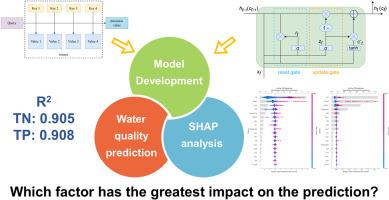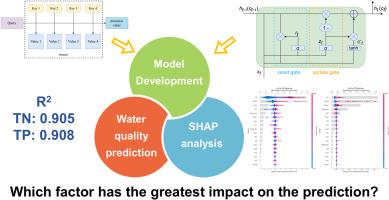基于可解释深度学习模型的半干旱区典型河流水质参数预测及污染超标分析
IF 7.3
2区 环境科学与生态学
Q1 ENVIRONMENTAL SCIENCES
引用次数: 0
摘要
整合环境特征的深度学习模型为高精度水质预测提供了有力手段;然而,它们的黑箱性质限制了可解释性和可靠性。为了提高预测精度和结果的透明度,提出了一种可解释的关注门控循环单元(AT-GRU)模型,该模型将半干旱的大黑河流域的水质、气象和水文数据整合在一起。与传统的机器学习和深度学习方法相比,该模型具有更高的日尺度预测精度(平均R2 = 0.907)。为了提高可解释性,进行了SHapley加性解释(SHAP)分析,以确定预测背后的关键驱动因素。结果表明,氨氮(NH3N)、种群数量和河流流量是高污染条件下总氮(TN)和总磷(TP)的主要预测因子,气象因子的影响有限。发现极端降水事件会暂时提高营养物浓度。对异常和极端情况的分析进一步突出了最有效的管制干预的具体时期。总的来说,我们的研究提供了一个基于数据和机制的建模框架,支持半干旱地区有针对性的污染控制、早期预警和适应性水质管理策略。本文章由计算机程序翻译,如有差异,请以英文原文为准。


Prediction of water quality parameters and pollution exceedance analysis in typical rivers of semi-arid regions based on interpretable deep learning models
Deep learning models that integrate environmental characteristics provide a powerful means for high-precision water quality prediction; however, their black-box nature can limit interpretability and reliability. We proposed an interpretable Attention-Gated Recurrent Unit (AT-GRU) model that integrates water quality, meteorological, and hydrological data from the semi-arid Dahei River Basin, to improve prediction accuracy and transparency of results. The model achieved superior daily-scale prediction accuracy (average R2 = 0.907) over traditional machine learning and deep learning approaches. To enhance interpretability, SHapley Additive exPlanations (SHAP) analysis was conducted to identify key drivers behind the predictions. Results indicated that ammonia nitrogen (NH3N), population count, and river flow were the dominant predictors of total nitrogen (TN) and total phosphorus (TP), while meteorological factors had limited influence under high-pollution conditions. Extreme precipitation events were found to temporarily elevate nutrient concentrations. Analysis of exceedances and extremes further highlighted specific periods of most effective regulatory interventions. Overall, our study contributes a data- and mechanism-informed modeling framework that supports targeted pollution control, early warning, and adaptive water quality management strategies in semi-arid regions.
求助全文
通过发布文献求助,成功后即可免费获取论文全文。
去求助
来源期刊

Environmental Pollution
环境科学-环境科学
CiteScore
16.00
自引率
6.70%
发文量
2082
审稿时长
2.9 months
期刊介绍:
Environmental Pollution is an international peer-reviewed journal that publishes high-quality research papers and review articles covering all aspects of environmental pollution and its impacts on ecosystems and human health.
Subject areas include, but are not limited to:
• Sources and occurrences of pollutants that are clearly defined and measured in environmental compartments, food and food-related items, and human bodies;
• Interlinks between contaminant exposure and biological, ecological, and human health effects, including those of climate change;
• Contaminants of emerging concerns (including but not limited to antibiotic resistant microorganisms or genes, microplastics/nanoplastics, electronic wastes, light, and noise) and/or their biological, ecological, or human health effects;
• Laboratory and field studies on the remediation/mitigation of environmental pollution via new techniques and with clear links to biological, ecological, or human health effects;
• Modeling of pollution processes, patterns, or trends that is of clear environmental and/or human health interest;
• New techniques that measure and examine environmental occurrences, transport, behavior, and effects of pollutants within the environment or the laboratory, provided that they can be clearly used to address problems within regional or global environmental compartments.
 求助内容:
求助内容: 应助结果提醒方式:
应助结果提醒方式:


